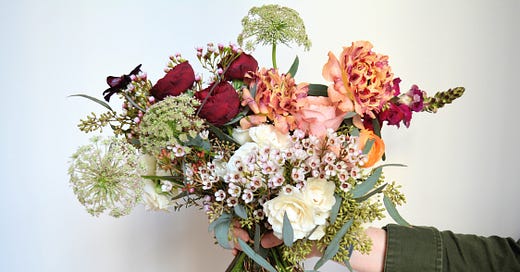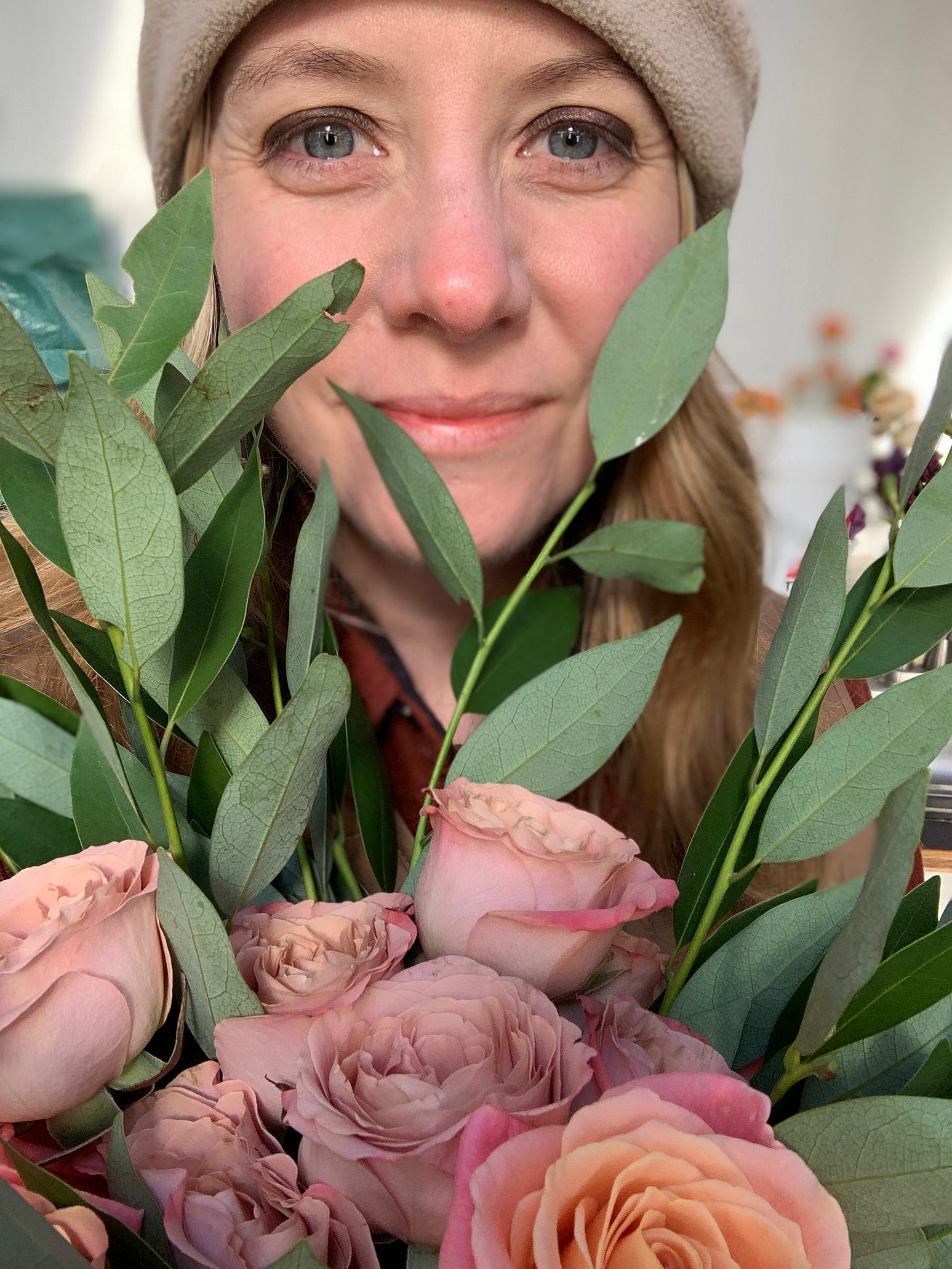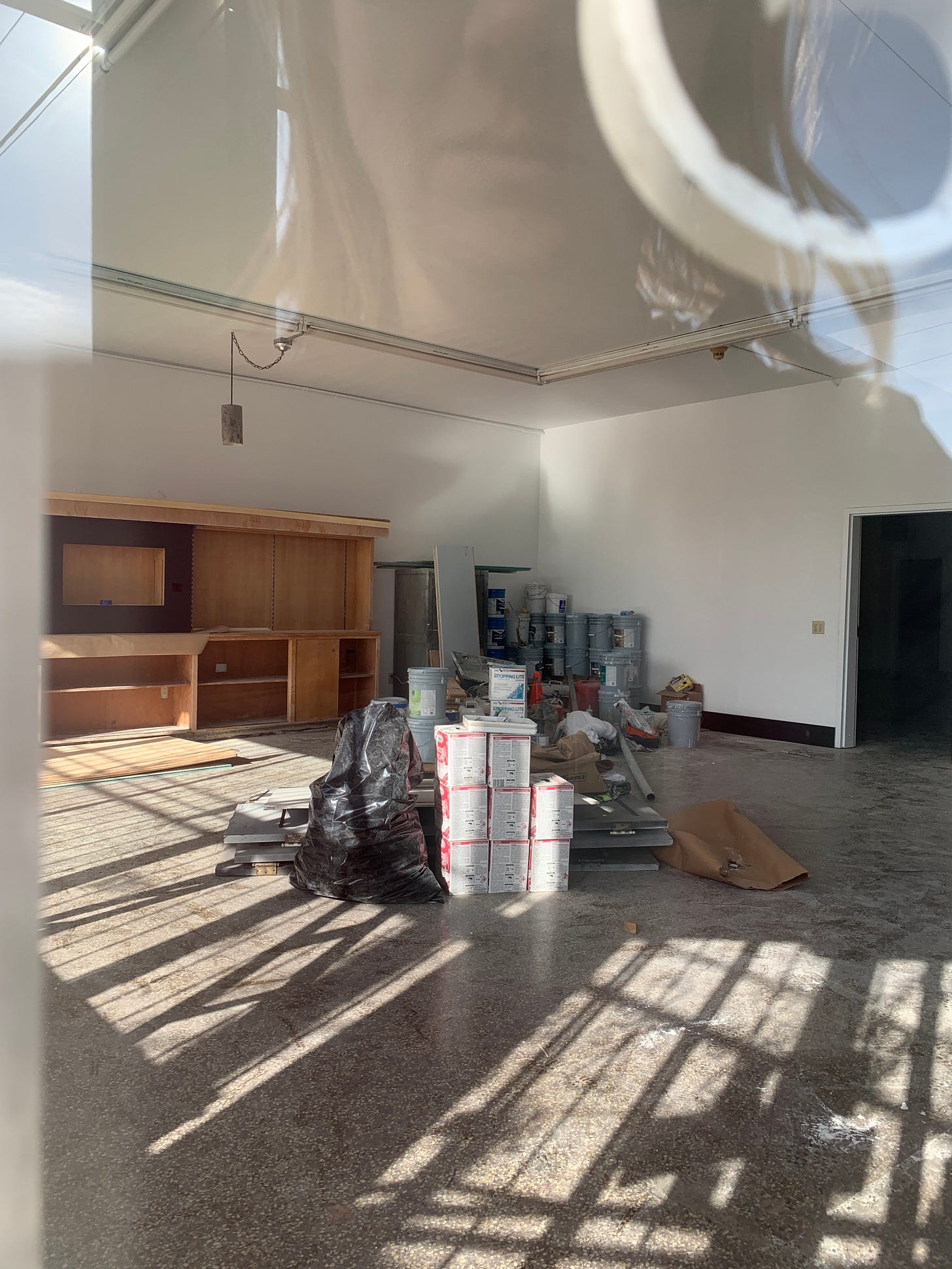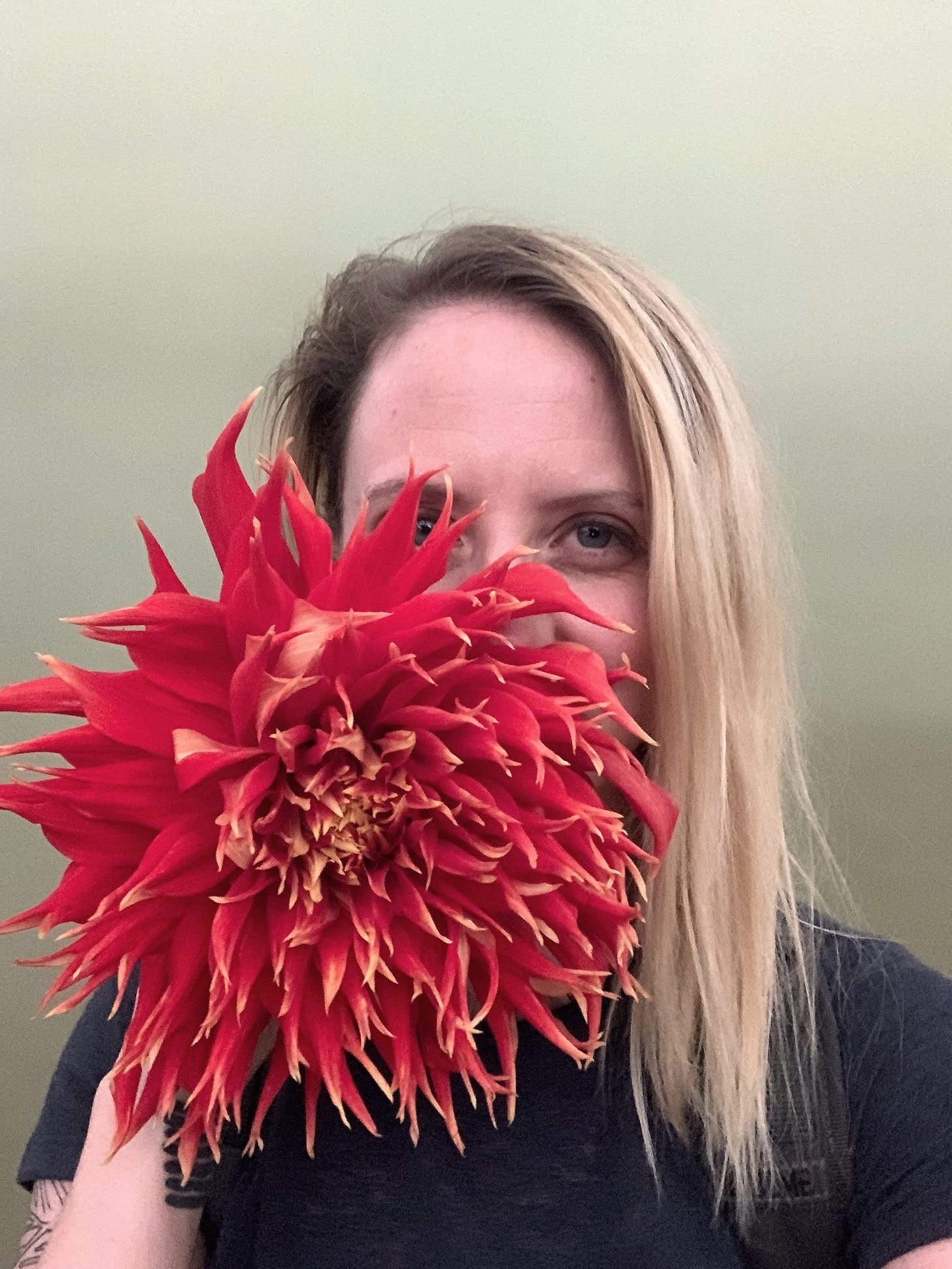How I ended up owning a flower shop when flowers aren't my thing
And you may ask yourself, "Well, how did I get here?"
Welcome. I’m Katherine Raz. I own a shop in Tacoma, Washington called The Fernseed and this is my newsletter about running an independent retail business in the age of Amazon. If you’re a shop owner, or you sell products to small retail businesses, or you’re just curious what this whole business is about, you’re in the right place. (And if this email was forwarded to you, you can sign up to receive it yourself right here. It’s free!)
True confession: I’ve never been a flowers person.
I rarely buy fresh cut flowers because I think they die too quickly and I’m terrible at composting them before they turn swampy.
On my wedding day, I bought my bridal bouquet at the grocery store.
In high school, my best friend’s life’s dream was to own a flower shop, and even at sixteen, I remember thinking how different we were because she adored the intricate beauty of flowers and I just thought they were boring. I could see owning a record store, maybe.
It’s not that I’m against flowers, I just feel the same about them as I feel about impressionism, or baking. Meh?
Not only was I not into flowers, as a person with an obsessive interest in how businesses operate, I knew flower shops were like restaurants, an enterprise people foolishly leap into thinking, “How hard can it be?”
In my former life as a marketing consultant, I used the example of a flower shop in exercises I led at the Women’s Business Development Center. We’d map out the different types of customers a florist had—funeral homes! wedding venues! hotels!—as an example of a business that seems simple from the outside, but is actually incredibly complex. I was just about as interested in opening a flower shop as I was in opening a bakery. That is, not at all. Terrible margins! Lots of hard work! Flowers! Not for me.
It’s amazing that for all I thought I knew about running a flower business from those sample exercises, it was my naiveté about the actual physical labor of arranging flowers that opened the door for the momentary lapse of reason that launched our plant shop into the floral business begin with.
It started with our first Valentine’s Day, February, 2020. I had been thinking about products we could sell to make plants more of a thing for the holiday (pink plants?) when it occurred to me, “Why swim upstream?” One of our recent hires had floral design experience and had worked at a floral wholesaler in San Diego. She could probably make a few bouquets, right?
But then there was the issue of the fancy grocery store down the street. How could we differentiate our Valentine’s Day flowers from their bouquets, which would likely be less expensive? Is there such a thing as “sustainable” in the flower business? So I Googled.
Then I discovered something that piqued my interest. Most of the flowers sold at retail in the United States are grown in Colombia and Ecuador under questionable labor conditions, then treated with chemicals so they last the journey to Florida before they’re flown to distributors all over the country. They’re wrapped in plastic, and the chemicals used to preserve them eliminate their fragrance. Most florists use floral foam (the mushy green stuff in the base of vases used to keep stems from shifting in an arrangement), which contains formaldehyde and other harmful chemicals, and prolonged exposure to it can cause cancer.
Then I discovered there’s a growing “slow flowers” movement, whose supporters advocate local, seasonal, and domestic floral product, as well as transparent origin labeling, so consumers understand where their botanicals come from.
This was right up my alley.
“You mean to tell me,” I pondered, probably rubbing my greedy hands together, “that there isn’t a flower shop in Tacoma selling locally-grown botanicals and eliminating plastic and foam from its supply chain?”
How hard can it be?
The next week, my de facto floral designer and I drove to the major floral wholesaler in Seattle to ask some questions. Could we get locally-sourced product for Valentine’s Day? (For people like me who don’t think about these things, let me explain: roses are not in season in Washington in February.)
This is where things got the-universe-is-trying-to-tell-you-something-ish.
If we wanted locally-grown product, the wholesaler told us, it was available in the attached building, which housed the Seattle Wholesale Growers Market, a farmer-owned flower grower cooperative. This was a network of regional flower farms, under one roof, offering locally-grown flowers at wholesale.
BOOM! I got your sustainable, locally-sourced Valentine’s Day bouquet right here.
So we bought some locally-grown product (the roses were from Oregon and California), made some sample arrangements, took photos, and offered them for pre-sale on the Fernseed website.
Then we pre-sold 55 Valentine’s Day bouquets.
Again, my naiveté really served me here. While our floral designer was internally freaking out, I was filling a sleeping bag with dollar bills and rolling around in it.
Did it matter that our shop was only 750 square feet with no back room and no refrigeration? No!
Did it matter that we had only one person trained in bouquet-making, and 55 orders queued up for a single pickup day? Of course not!
Did it matter that we didn’t own a single 5-gallon bucket, or a single pair of floral snips, and that no one had actually figured out how to wrap a bouquet in kraft paper, or keep stems moist without using plastic? No! Why would any of those tiny details stop us?
(You ever wonder why I have a FYRE Festival poster hanging in my office? Now you know.)
Our floral designer calmly communicated to me that we were woefully underprepared for this operation. We needed more floral designers, more space, at least 25 five-gallon buckets, and refrigeration. So she set to work hiring freelancers and sourcing biodegradable packaging and buckets, and I figured out that we could use the sun room at my house as a work space, because it was under a separate heating system, and could be kept cold in February.

Two years later, I’m fully aware that 55 bouquets can’t be made over the course of a week. But at the time it didn’t occur to me that flowers have a short shelf life. This means whatever raw product you order for bouquets has to land at maximum three days prior to when it needs to go out as a styled arrangement, and during busy holidays, this creates a labor bottleneck. If it takes one designer 20 minutes to make a bouquet, that means they can make 24 bouquets during the course of an 8-hour work day, not counting breaks. It also doesn’t account for the fact that botanical ingredients need to be prepped on arrival: unboxed, unwrapped, stems stripped, thorns removed, roses dipped in “quick dip” to help extend shelf life. It’s a lot of work crammed in to a short time, so you need a lot of hands to assist with labor.
Valentine’s Day 2020 was on a Friday, with pickups starting Thursday. So we had flowers delivered Tuesday, followed by a day of prep with three people. Wednesday, five floral designers worked for several hours building the arrangements, and then I stayed up until midnight wrapping them in kraft paper. The following day we had four floral designers building the remainder of the arrangements, and I stayed up late again to wrap them all.
All in all, it was a logistical success! And we proved the concept. But it was a financial failure.
Here are some stats from that first Valentine’s Day:
Cost of goods was $3,404 on $2,680 in sales
Expenses were another $3,832
Freelance labor was $500
Loss of $5,056
$823 of supplies (can be used in future!)
I was not deterred by those numbers. We had proven the concept, and found a gaping hole in the market. We could figure out the rest. Time to plan for Mother’s Day, right?
Then Covid happened.
And here’s the weird thing: had it not happened, our fledgling floral business probably would have failed.
After Valentine’s Day I started searching for a second retail space for this flower shop concept, which, at the time, we were planning to launch under a different name (Forager Floral). I almost signed a lease on a space that was too large, and if we would have separated the two businesses, Forager would never have been self sustaining.
But Covid changed all that. We had to temporarily close our Proctor location for almost three months, so I never signed the second lease. In order to stay afloat financially, we overhauled our website and started offering plants for local delivery. It was during this process that Shoppe Theory, our web designers, offered branding advice that, I’m convinced, saved the shop: ditch Forager. Bring the flower business under the Fernseed brand.
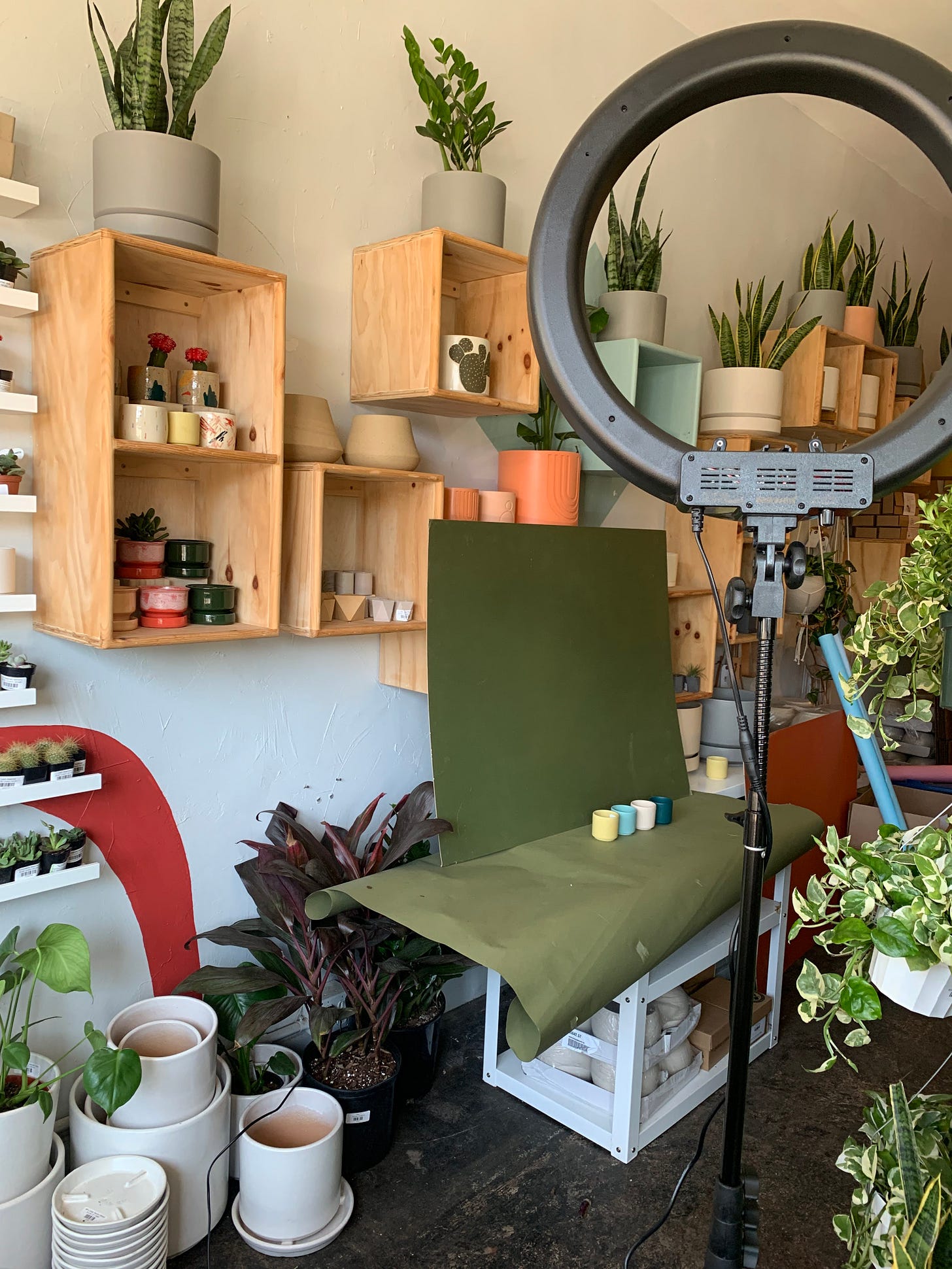
Whether we opened a flower shop or not, we were going to need more space if we were going to continue our e-commerce business and plant delivery. The Proctor shop was too small to house those operations, so in April of 2020, so I started looking for warehouse space. But warehouse space with freight access and natural light, I discovered, was more expensive to rent than retail space that better met our requirements.
Then I found a corner storefront in Tacoma’s South Tacoma business district with natural light, lots of retail space, and an adjacent room that could be used for storage and prep. But ugh, are we really going to open a second storefront 6 miles from our original store?
I knew we could launch a flower business at the South Tacoma Way shop because it had the square footage we needed and a separate room with no windows that could be kept cool. But I could not figure out how it would make sense in our customers’ minds that we now had two locations, one of which was a flower shop.
Why am I doing this again? Because we need the space. Then why not just rent a warehouse? Because it’s just as expensive, and you might as well take advantage of a trickle of retail traffic if you can get it. Then why not open in a slightly different market, like Gig Harbor, or Puyallup? Because, for operational efficiency and staffing reasons, you need to stay in Tacoma.
This is the phase of entrepreneurship that I dread. Some people call it the “pre-launch jitters,” but I call it the “it seemed like a good idea at the time, but now I’m convinced that we are navigating full steam into a massive public failure that will ruin me” moment. Fun to talk about in hindsight! Terrible to be in the midst of, partly because when you are the sole person in charge, and people’s jobs are on the line, you absolutely cannot allow that terror to show up on your face in the workplace every day. But you feel it. Oh, you feel it.
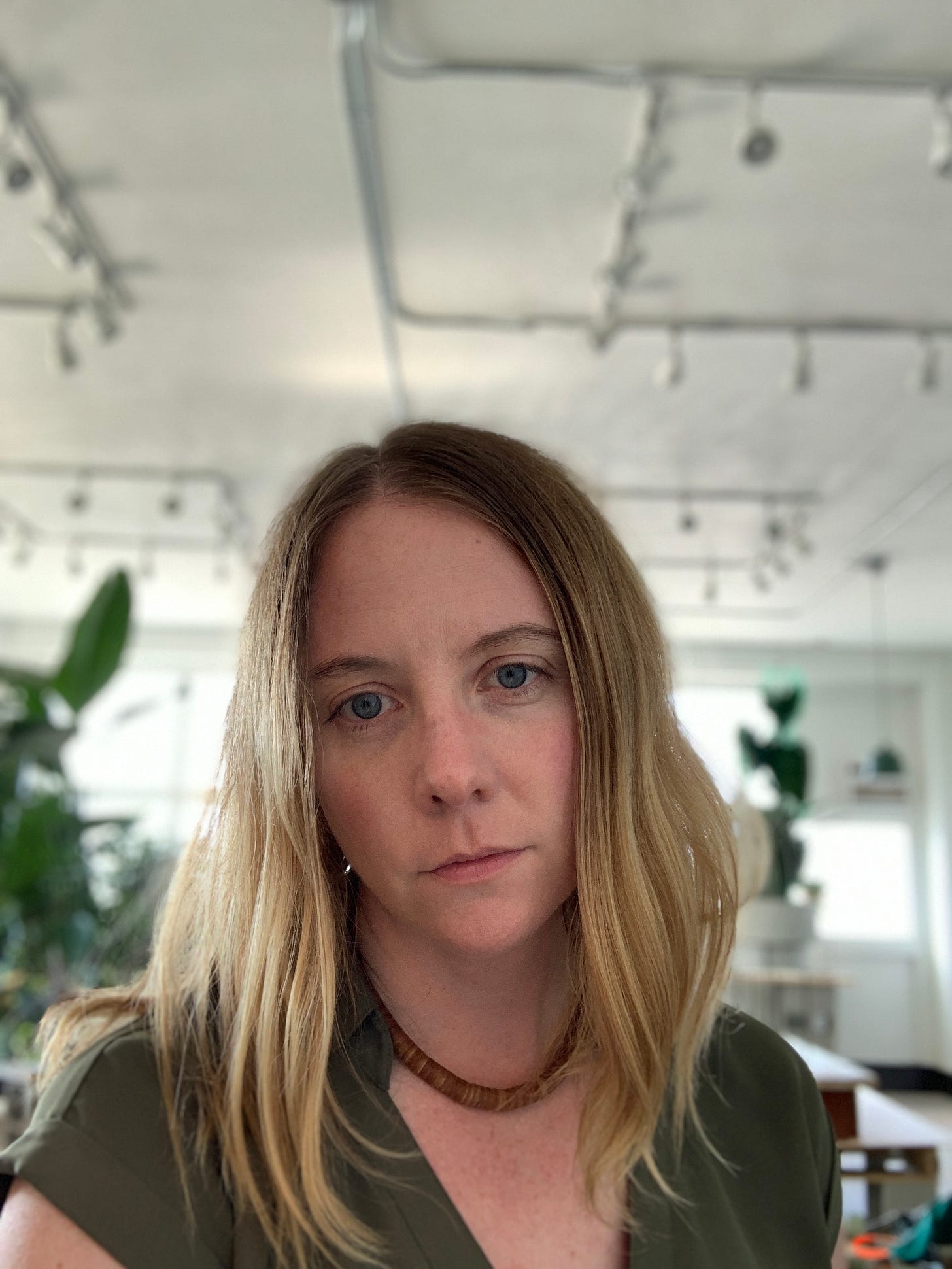
I called a friend of mine in Denver who I knew could talk me off the ledge. She’s a realtor, but she’s also a branding and marketing expert who can pick apart any business idea and put it back together again.
“Tracey!” I sobbed into the phone, pacing in my driveway. “What even is this thing I’m creating, and why?”
“Your customers will figure it out for you,” she said. “Stop doing the work of trying to make this second location make sense from a branding perspective, and just open the doors. As the public interacts with it, it will become its own thing.”
Gah, Tracey, you genius!
The learning is in the doing. I know this! I know it so much that I give the same advice all the time: open the doors, and let your customer interactions guide you in the process. It’s the Lean Startup, a book I don’t even own despite buying it several times because I always give it away. But while I was actually living it, I couldn’t see how it applied to me because I was convinced that, unlike every other business that has faced this challenge, I was uniquely positioned to fail.
So in September of 2020, in the midst of a raging pandemic, we opened the doors to our second location. We made a commitment to source 60-70% of our floral product locally (within 400 miles of Tacoma). We offered four products for delivery: two sizes of wrapped bouquets and two centerpieces. We set up our retail floral products as a stem bar, in vases, priced individually, so customers could build their own bouquets.
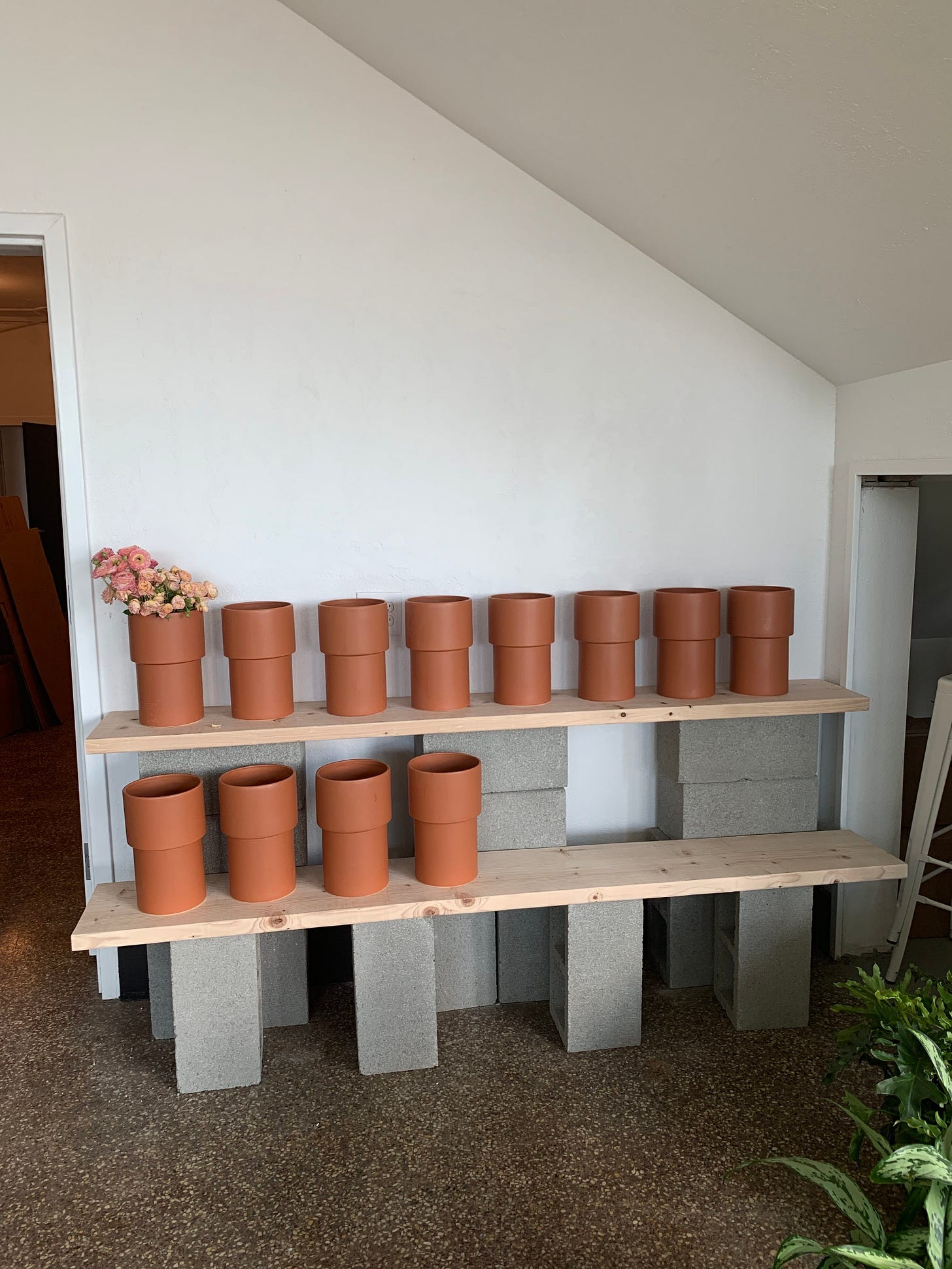
Once again my ignorance about proper handling of floral product served me in the engineering of a customer experience that was less practical from a business side, but works as a differentiator. Most flower shops sell pre-made arrangements out of coolers, but I wanted our customers to be able to touch and smell the product. We lose more product this way due to lack of cold storage, but I love how it brings the experience of gathering an arrangement, like you might on a hike, inside a retail shop. This also gave us the opportunity to label each stem by origin: Oregon, Tacoma, California, etc.
Because we didn’t have money for furnishings, we built fixtures with cinder blocks, paving bricks, pine planks, and wood pallets. I wanted to understand how traffic flowed through the shop, as well as how sun exposure from the south and west-facing windows affected the plants and flowers, before we invested in permanent fixtures. (Fun fact: I borrowed this idea from the Crate and Barrel origin story. The company is called Crate and Barrel because the founders also ran out of money for store fixtures, and named the shop after the leftover shipping containers they used to display products on opening their first Chicago location.)
Because we already had people working at the retail store, and our sales were primarily from plants and pottery, we had breathing room to grow our floral sales without obsessively tracking margins that included cost of labor. If we would have started as just a flower shop, we would not have been able to sell enough floral product to cover those costs.
While this helped us stay afloat, I made a management mistake in keeping the floral staffing too lean. When we opened South Tacoma, we only had one floral designer. They were responsible for the weekly floral order as well as building arrangements for delivery, and they also ran the retail shop during their shift.
This kept costs down, but led to burnout. While we did train enough of our existing staff to build arrangements by the important floral holidays in 2021 (Valentine’s Day and Mother’s Day), I simply did not prioritize floral hiring or training.
I also made in error in assuming that a person experienced floral design would embrace the pressures associated with the business side of things. It is a difficult job to keep a retail stem bar stocked, while ordering enough product to anticipate delivery volume on any given day (let alone holidays), while also being expected to keep waste minimal, all while developing and marketing new products, as well as ordering floral supplies, all while being expected to help retail customers during most shifts.
It is no wonder that by August of 2021, our original floral department manager quit. I take full responsibility for their resignation.
I was hiding behind the “owner, not chef” mentality. A year in to owning a flower shop, I still could not build arrangements for delivery. I also did not have a granular breakdown of the margins on each floral product we sold. In my defense, I was too busy working on other areas of the business to devote time to this, and I had a general manager who took the reins on this part of the business so I didn’t have to. But it was a tangled mess of job roles and responsibilities that I was too distracted to sort out. That was a mistake.
After our founding floral designer quit, we posted a job listing for a floral department manager, and one of our current employees, who had previously worked as a restaurant chef and at a dog daycare, expressed her interest in taking over the position. She had been with the business for six months and in that time had exhibited a talent for design, but I didn’t want to make the same mistake of putting someone in the position to manage the department who couldn’t handle the business side. So I asked her, “What do you think qualifies you to anticipate order volume for a busy holiday? You have to order product for multiple products from multiple vendors and keep waste minimal. Are you up for that?”
“I think so. I used to be head chef at a restaurant?”
Lightning. Bolt.
This is a chef’s job! If you can order enough eggs for Mother’s Day brunch, you can order flowers for Mother’s Day with the same mentality.
So last fall, we hired two additional retail florists who could work front-of-house while our newly-promoted department manager worked on recipes and ordering. I am happy to say they are all doing a phenomenal job.

In addition to increasing our sales and improving overall floral margins, our new floral department manager and our general manager expanded our relationships with local growing, buying flowers from people in the surrounding neighborhoods who were growing in their back yards. This was the essence of the flower business I had hoped to start and grow, and I was fortunate to have two people on staff with enough bandwidth and passion to devote to that project. It was incredible to show up to work to see these backyard flower vendors dropping by with fresh, hyper local product, and it came at a time when I really needed that moment to reconnect with the reason I got myself into this business to start with.
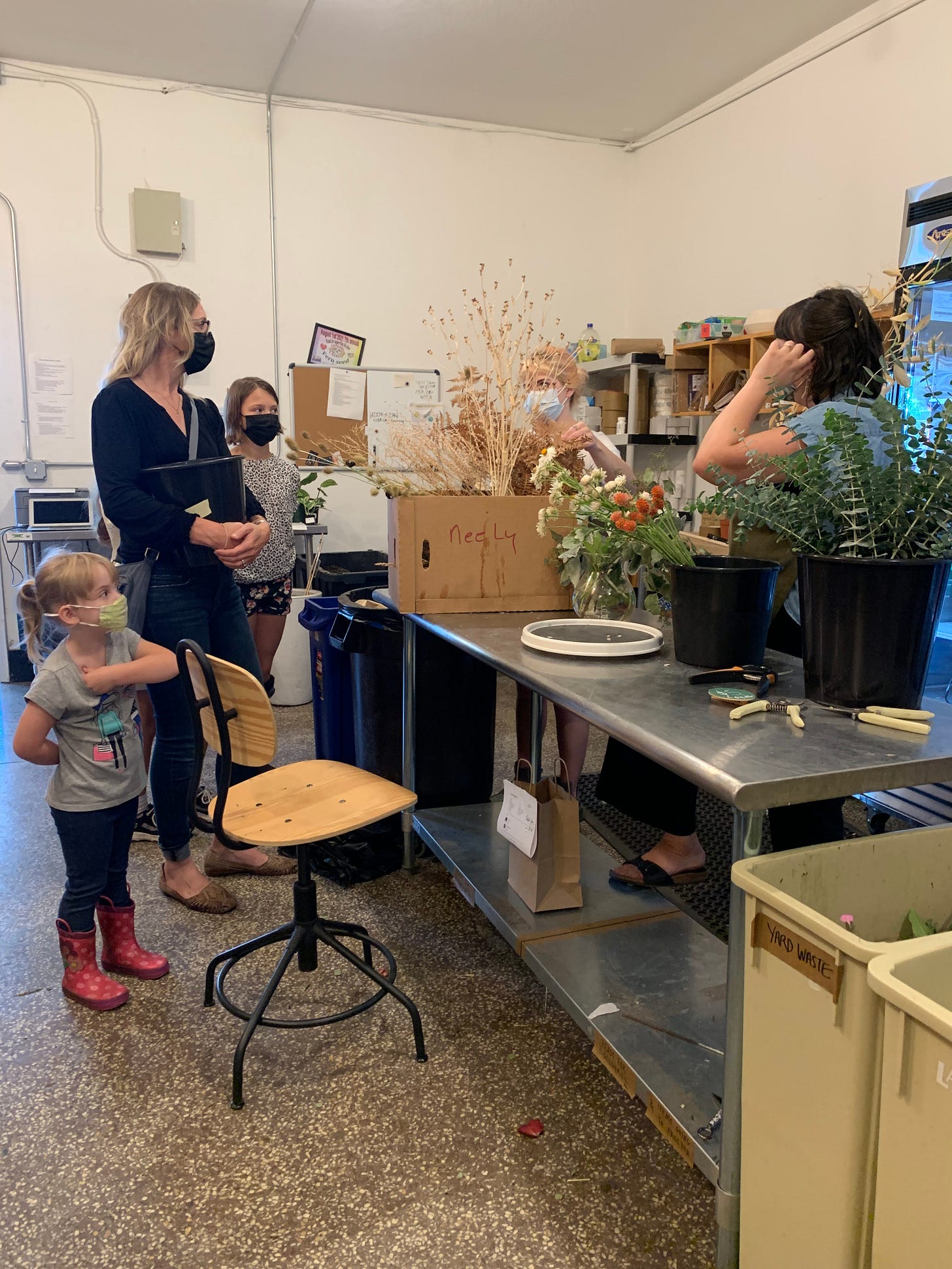
I still have improvements to make in how I manage things. This year, I’m taking a more active role in both understanding and controlling our floral pricing, as well as learning how to build the arrangements we send out for delivery.
I experienced a real moment of truth while watching my The Profit, where entrepreneur and investor Marcus Lemonis visits businesses in crisis and offers investment and turnaround advice. It’s a cheesy reality show with a lot of really great business lessons peppered throughout. (This show, How I Built This, and Shark Tank, have been my MBA. Thanks, content creators!) In an episode featuring a pizza restaurant in Santa Monica, Marcus grills the owner about margins, down to the weight of shredded cheese used on a pizza, and the owner has no idea what the ingredient costs are. Big mistake! Reality TV show public shame!

“We cannot leave here today until we know what a pizza costs,” Marcus tells him.
The day after watching this episode I started a spreadsheet with every cost involved in building and sending out every floral product on our menu. After years of watching The Profit and Shark Tank, I refuse to be the owner who stands dumbstruck in front of a camera crew without a granular understanding of our margins.
One of my 2022 goals is to make sure that everyone who works in the floral department adheres to recipes that maintain these margins. To do this, we have to work recipes into our floral training as well as our regular staff review process.
We still have a lot going on at the shop these days, including emergencies we never could have planned for. But between putting out fires and working on high level business stuff, I’m spending 30 minutes here and there in the work room learning how to build every floral product we make. This isn’t performative, it’s a practical necessity. We’re still grappling with Covid, and if I’m committed to preventing burnout, it’s essential that I can step in and build arrangements if we’re unexpectedly short staffed—and I’m sure we will be at some point.
We’re still mid-stream in all of this. We have major vulnerabilities, staffing issues to solve, problems to work out.
I still wake up some days wondering how I ended up as a flower shop owner, but I think I’ve learned more about managing a business I had no business launching in the first place than I would have by tackling something I had more knowledge of to start, and that has been a great learning experience.
And now I have to say that I actually, kind of sort of really like flowers.

